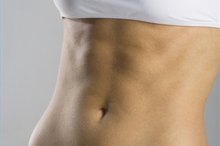What does fact checked mean?
At Healthfully, we strive to deliver objective content that is accurate and up-to-date. Our team periodically reviews articles in order to ensure content quality. The sources cited below consist of evidence from peer-reviewed journals, prominent medical organizations, academic associations, and government data.
The information contained on this site is for informational purposes only, and should not be used as a substitute for the advice of a professional health care provider. Please check with the appropriate physician regarding health questions and concerns. Although we strive to deliver accurate and up-to-date information, no guarantee to that effect is made.
How to Get Rid of Fat in the Forehead
Forehead fat may not cause any harmful health problems, but it can effect an person's self-confidence. Unattractive facial fat, especially forehead folds, can be challenging to get rid of, but not impossible. Through proper diet and exercise, many people can reduce forehead fat and keep it off. However, diet and exercise take commitment and work, and seeing results may take a while. Many people opt for a faster solution through cosmetic surgeries or non-surgical face-lift procedures that can remove forehead fat folds, providing long-term results.
Lose weight. Cardiovascular exercises burn fat--this means in the face as well. Depending on your particular facial structure, you may burn more forehead fat than others. Needless to say, overweight individuals will have more forehead fat than those who are not overweight.
How to Get Rid of Cellulite on the Legs Fast
Learn More
Stay hydrated. Drinking more fluids can aid in weight reduction. Drink eight glasses a day to reduce overall weight gain and excess facial fat.
Try forehead lift exercises. Firming the fat underneath the skin can reduce the appearance of forehead fat. Place index fingers above eyes, pulling downward, while trying to raise eyebrows. Repeat 10 times. This is a simple exercise that can be executed three to four times a day.
How to Get Rid of Fat Pockets Under Your Eyes
Learn More
Have a liposuction procedure done. A certified surgeon can remove fat layers underneath the forehead by making a small incision on the forehead and sucking the fat out. The liposuction on the forehead can be an effective procedure, with minimal health risks and post-surgery complications. Liposuction results can last for up to several years if the patient does not gain an excessive amount of weight.
Get a face-lift 1. Face-lifts can be done with or without surgery 1. Talk to a specialist to determine which method would be the most effective. Some cosmetic specialists can offer laser or radio frequency waves to dissolve forehead fat. Others may suggest Botox treatments--a procedure that smooths the forehead fat lines by eliminating their wrinkles, which are mainly produced by fat folds 2.
Related Articles
References









